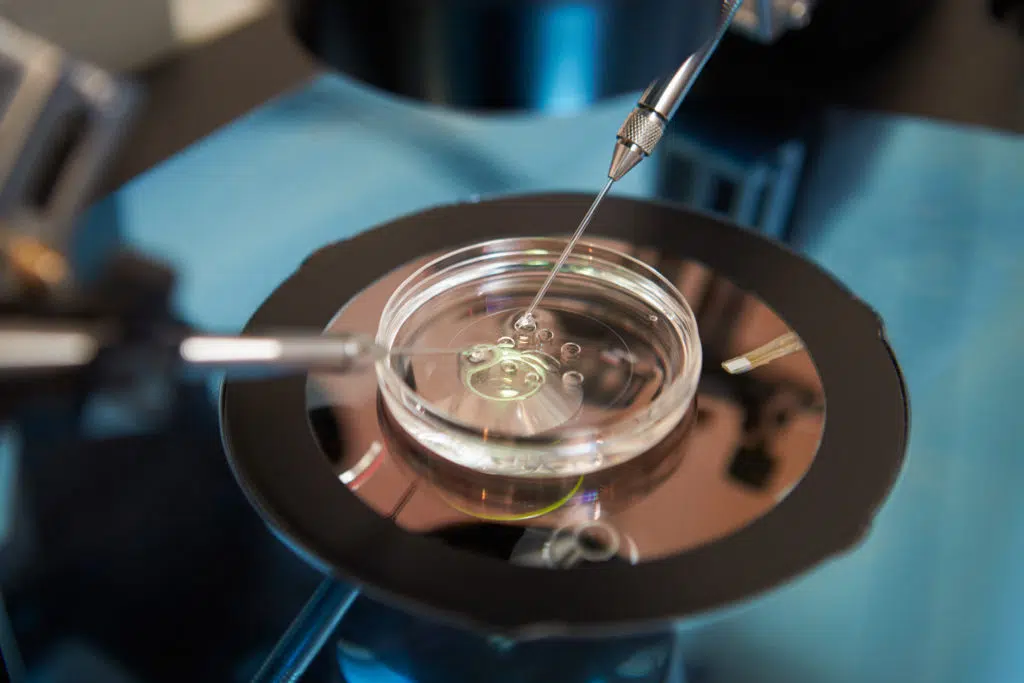The Catholic Church teaches that in vitro fertilization is immoral because it not only commodifies a person but also eliminates the marital act from that person’s creation. In addition, it can lead to the deaths of tiny preborn children when unwanted embryos are discarded or used for testing.
This is a bitter pill to swallow for a couple desperate to have a baby. For all those facing infertility, please know that the Church hears and understands your pain.
The Church does not want you to suffer or hurt, but she must also look out for and protect the baby and the sacrament of marriage. That is why she teaches the immorality of IVF. There are very valid reasons for this teaching. The USCCB succinctly explains it in a document entitled “Begotten Not Made:”
In vitro fertilization brings about new life in a petri dish…. The egg and sperm are ultimately joined in a glass dish, where conception takes place and the new life is allowed to develop for several days. In the simplest case, embryos are then transferred to the mother’s womb in the hope that one will survive to term.
Obviously, IVF eliminates the marriage act as the means of achieving pregnancy, instead of helping it achieve this natural end. The new life is not engendered through an act of love between husband and wife, but by a laboratory procedure performed by doctors or technicians. Husband and wife are merely sources for the “raw materials” of egg and sperm, which are later manipulated by a technician to cause the sperm to fertilize the egg.
Traditional IVF involves the sperm fertilizing the egg in a petri dish outside the body. There are many different types of IVF, including gamete intrafallopian transfer (GIFT), zygote intrafallopian transfer (ZIFT), and frozen embryo transfer (FET). As we will see, GIFT is “closer to natural conception” than regular IVF. The Church has not yet declared whether this fertility treatment is moral or immoral, but it’s important to understand the procedure and the ramifications.
Then we’ll introduce you to a natural and moral fertility method called NaProTECHNOLOGY. This is a different medical approach to overcoming infertility that is entirely moral, and has helped countless spouses conceive a baby.
So let’s explore three different kinds of IVF and their moral implications.

Gamete Intrafallopian Transfer (GIFT)
In gamete intrafallopian transfer, or GIFT, fertilization takes place in the woman’s body rather that outside of it in a petri dish. According to the USCCB, “It involves obtaining a husband’s sperm following marital relations and aspirating an egg from the wife’s ovary. Egg and sperm are placed in a tiny tube separated by an air bubble, and the contents of the tube are then injected into the wife’s fallopian tube with the hope that fertilization will occur.”
In this process, the doctor will make an incision in the woman’s abdomen. He will then use a laparoscope—a small surgical instrument that helps him see—to place the sperm and eggs directly into the fallopian tube. The doctor usually uses more eggs in this process in an attempt to ensure fertilization. The hope is that at least one egg will become fertilized by the sperm.
According to the USCCB:
Some theologians consider [GIFT] to be a replacement of the marital act, and therefore immoral. Other theologians see it as assisting the marital act, and therefore permissible. Because the teaching authorities of the Church—the pope and bishops—have not made a judgment about GIFT, Catholic couples are free to choose it or reject it depending on the guidance of their own conscience. If the teaching authority of the Church should judge the procedure to be immoral, however, GIFT should no longer be used.
The St. John’s Institute of Clinical Bioethics offers a perspective on why GIFT might have a place in a Catholic fertility care system:
From the Catholic moral standpoint, the ethical dilemma associated with GIFT revolves around the question whether the intervention of the physician or the technician should be considered an assisting act of or a substantive one for the natural marital act. The facts that few oocytes are needed, that they are introduced into the fallopian tube after a short interval of time together with the spermatozoa obtained during or immediately after a conjugal act and that fertilization is inter-corporeal without any embryo manipulation reasonably classify that technique as a form of assistance and not a substitute for the conjugal act. In that case, the GIFT technique is morally acceptable.
The National Catholic Bioethics Center offers a different opinion, explaining why GIFT might actually be immoral:
An important Vatican document known as Donum Vitae (On the Gift of Life) emphasizes that morally acceptable interventions used in procreation cannot be a substitute for the marital act but should serve to facilitate that act to attain its natural purpose. Even when sperm is collected in an acceptable manner, by using a silastic sheath during marital relations (i.e., a perforated condom without any spermicide), it still appears that the subsequent steps of GIFT and IUI involve a substitution/replacement of the conjugal act by injecting the sex cells into the woman’s body via a cannula. In other words, the marital act does not itself cause a future pregnancy but only enables the collection of sperm, which is then used for another procedure that brings about the pregnancy.
Because the Church has not yet declared GIFT to be morally licit or illicit, spouses must use their conscience to guide their choice. They must understand both the process and the risks. Further, the woman’s body has to be able to make eggs. And she must have a healthy fallopian tube.
Zygote Intrafallopian Transfer (ZIFT)
In the traditional IVF process, the egg is fertilized in a petri dish and then observed in the laboratory for three to five days. But in ZIFT, the eggs that are fertilized, which are known as zygotes, are placed directly in the woman’s fallopian tubes, usually within 24 hours.
Similar to GIFT, ZIFT is also performed with the use of a laparoscopic tool. However, because the egg is fertilized outside the woman’s body, fewer eggs are used.
This process is morally illicit because the egg is fertilized outside the woman’s body.
Frozen Embryo Transfer (FET)
In frozen embryo transfer, a woman will receive a thawed embryo who has already been created, but who has been frozen. Typically, this is from a past IVF treatment during which several embryos were created but not implanted.
To transfer the embryos, the doctor will use a small tube—or catheter—to move the embryo through the cervix and then into the uterus.
This process is morally illicit because it involves the traditional IVF treatment in which a child was created in a lab, then frozen, and implanted.
Success Rates
When gathering statistics, the CDC groups together all the different assisted reproductive procedures, so it’s difficult to know their individual success rates. It does state that a 2017 report that combined the success rates of these techniques found that
- 3% of all cycles that used the woman’s own eggs or embryos led to successful pregnancies.
- Single-fetus pregnancy accounted for about 70% of the pregnancies.
- Multiple-fetus pregnancy accounted for 23% of the pregnancies while the number of fetuses could not be determined in 7% of the pregnancies.
- About 70% of the cycles carried out did not result in a pregnancy.
- Less than 1% of all cycles resulted in an ectopic pregnancy (the embryo implants outside of the uterus).
- About 82% of pregnancies resulted in a live birth.
The American Pregnancy Association says that the success rate with GIFT is high and that “experts think that the journey through the fallopian tube nourishes the new embryo, giving it a better chance of being healthy and able to implant in the uterus.” It goes on to say that “another reason for the increased success rate could be timing. The embryo arrives at the ‘right’ time for implantation, as opposed to IVF, in which the embryo arrives in the uterus when the doctor places it there, and that may not be the right timing for her body.”
We know that some embryos will not survive the process of freezing and thawing, especially if some of his cells are damaged. According to Life Fertility Clinic, if the embryos are frozen at the blastocyst stage, which is five or six days after fertilization, then they have about a 90% chance of survival. However, if they are frozen at an earlier stage, only about 80% survive.
That means that anywhere from 10-20% of the frozen babies die.
But couples do not have to go these routes. There is a natural way—NaProTECHNOLOGY—and its effectiveness rate is up to 80%.
NaProTechnology
For those couples facing infertility, there is hope. Doctors at the Saint Paul VI Institute have achieved great success in helping couples conceive children naturally by using natural procreative technology—or NaPro.
NaPro is a health science that helps women monitor and maintain their reproductive health. A woman will meet with a doctor who not only examines her but who listens to the problems she has been experiencing. Together, they will work to determine the causes of her infertility. With NaPro, the couple can be assured that all procedures and techniques are morally licit and cooperate with, rather than work against, the woman’s reproductive system.
Doctors and nurses who practice NaPro understand that every person created is made in the image and likeness of God from the first moment of creation. They know that the loss of even one of these tiny persons is a tragedy. Couples seeking fertility help with a doctor who practices NaPro can always be assured that the personhood of their future children will be respected.
The Importance of Acknowledging Personhood
Donum Vitae teaches: “Human embryos obtained in vitro are human beings and subjects with rights: their dignity and right to life must be respected from the first moment of their existence.”
A preborn baby—no matter what his stage—is a unique and unrepeatable human being from the moment he is created. This is true no matter how tiny he is or how developed he is. We don’t need religion to tell us this. Science proves that a human being is created the moment the sperm fertilizes the egg.
Many in our country choose not to believe or acknowledge this scientific fact and favor instead a woman’s “right” to choose the death of her preborn child. But if, as a country, we were to acknowledge the personhood of a preborn baby from the time he is created, our laws would begin to reflect this fact. And if our laws began to change and acknowledge a preborn baby’s personhood, we would naturally have fewer abortions and see fewer IVF treatments.
Final Thoughts
Babies are unique and unrepeatable human beings—just like you, just like me. When we play God or treat children like commodities, we dehumanize them. So let us pray for all those facing infertility, and let us pray for a return to a Culture of Life where treatments protect rather than destroy the vulnerable.
Susan Ciancio has a BA in psychology and a BA in sociology from the University of Notre Dame, with an MA in liberal studies from Indiana University. Since 2003, she has worked as a professional editor and writer, editing both fiction and nonfiction books, magazine articles, blogs, educational lessons, professional materials, and website content. Fourteen of those years have been in the pro-life sector. Currently Susan writes weekly for HLI, edits for American Life League, and is the editor of its Celebrate Life Magazine. She also serves as executive editor for the Culture of Life Studies Program, an educational nonprofit program for k-12 students.












Great resource! I will share this!
Thank you, Dianne!